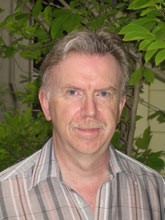
Handy Links
SLAC News Center
SLAC Today
- Subscribe
- Archives: Feb 2006-May 20, 2011
- Archives: May 23, 2011 and later
- Submit Feedback or Story Ideas
- About SLAC Today
SLAC News
Lab News
- Interactions
- Lightsources.org
- ILC NewsLine
- Int'l Science Grid This Week
- Fermilab Today
- Berkeley Lab News
- @brookhaven TODAY
- DOE Pulse
- CERN Courier
- DESY inForm
- US / LHC
SLAC Links
- Emergency
- Safety
- Policy Repository
- Site Entry Form

- Site Maps
- M & O Review
- Computing Status & Calendar
- SLAC Colloquium
- SLACspeak
- SLACspace
- SLAC Logo
- Café Menu
- Flea Market
- Web E-mail
- Marguerite Shuttle
- Discount Commuter Passes
-
Award Reporting Form
- SPIRES
- SciDoc
- Activity Groups
- Library
Stanford
Around the Bay
From the Director of Particle Physics and Astrophysics: Program Priorities in Uncertain Times

We are caught up in very uncertain times for federal science funding generally and for high-energy physics in particular. Currently SLAC is operating under a continuing resolution extending through April 8. As Persis reported in her column last week, there is reason to believe the FY2011 funding level for the Office of Science will be resolved before this expires. Given the overall fiscal situation, the Office of Science will then make decisions about where to apply the likely budget reductions, and issue guidance to laboratories and individual science programs about FY2011 funding levels.
In the meantime, Particle Physics and Astrophysics division management, along with the rest of the laboratory, has been developing plans that will allow us to react to various possible funding outcomes. Some of these scenarios will be very challenging; all of them need to address both the short-term impacts of a FY2011 budget decision made more than halfway into the fiscal year and the longer-term implications for funding in subsequent years.
Planning for the PPA program at any funding level is based on a set of priorities. Over the last three years, all the major elements of SLACís PPA program, along with those of the four other high energy physics laboratories, have been reviewed by external panels. These reviews were organized by the Office of High Energy Physics as a means of assessing and managing investments in the national program. The SLAC program emerged with strong grades in all cases, so clearly priority setting at this point means making choices among a portfolio of excellent existing and future opportunities.
As a national laboratory high energy physics group, PPA provides operating support for facilities and science-producing experiments in the U.S. program. These include the Instrument Science and Operations Center for the Fermi Large Area Telescope Collaboration, the BABAR Collaboration and its ongoing physics analysis of the SLAC B Factory data, designated U.S. management and operations activities for the ATLAS experiment at CERNís Large Hadron Collider, and commissioning and operation of the Enriched Xenon Observatory at the Waste Isolation Pilot Plant in New Mexico. These activities are commitments we have made to the national program.
A similar national commitment exists for the Large Synoptic Survey Telescope, or LSST, a project to be jointly funded by the Department of Energy and the National Science Foundation. SLAC has been designated by the Office of High Energy Physics as the lead laboratory for the design and construction of the projectís 3.2-Gigapixel camera. This is a case where we will be working with the guidance of an R&D funding profile, and eventually a construction profile, developed by the Office of High Energy Physics.
Next in priority are the active, science-producing efforts within the PPA program. Discovery physics at the energy frontier with the ATLAS experiment, exploitation of the exciting science program enabled by the Fermi Large Area Telescope, our vibrant theory program in particle physics and astrophysics, exploration of cosmic dark energy with the Dark Energy Survey, preparation for LSST science, and completion of the planned BABAR science program all fall into this category.
Finally, we have been developing a number of future science programs that would be realized on various time scales, but none have formally received project approval from DOE at this time, and their future prospects are uncertain. Among these R&D programs are ATLAS upgrades for a future high-luminosity phase of the Large Hadron Collider, the next phase of the Cryogenic Dark Matter Search experiment, detector R&D for a future Lepton Collider, development for a tonne-scale version of the Enriched Xenon Observatory, and contributions to a high-luminosity Super B Factory that would continue and extend the flavor physics started with BaBar.
In circumstances where budget reductions are expected, PPA will need to make difficult choices based on these priorities. Depending on the final level for FY2011, we probably will not be able to continue to pursue all of the future development efforts. This will clearly be painful, but the PPA program remains rich with existing and future exciting science opportunities. In this time of budget uncertainty, it is even more important that we all remain focused on maintaining the excellence of our science program.
